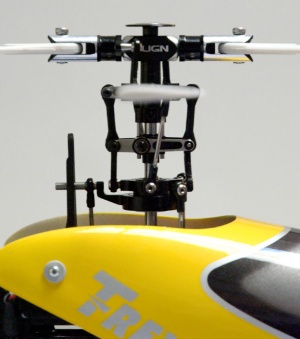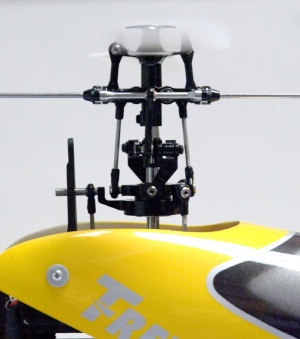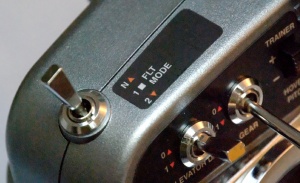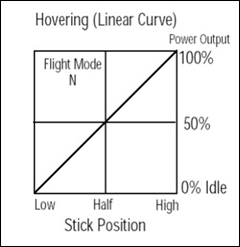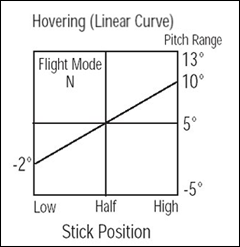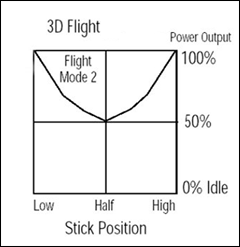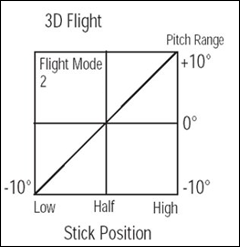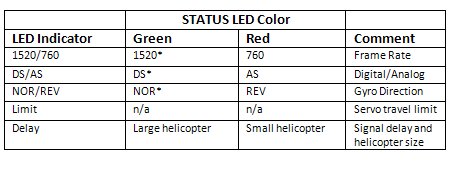T-Rex 250 Setup
This shows the setup of my T-Rex 250 and the experience I've had learning and experimenting with the build. Please visit RC Heli Wiki for an excellent resource regarding helicopter terms and concepts.
Follow this guide to-to-bottom, get a good mechanical setup before setting up the electronics. A great companion is Bob White a.k.a Finless' videos.
Prequesite
Follow the manual to setup the basic build and then use these steps to do the finer adjustments.
Receiver
AR6100e receiver setup (receiver - device):
- THRO - ESC
- AILE - Right cyclic servo
- ELE - Rear cyclic servo
- RUD - Gyro (3-wires plug)
- GEAR - Gyro (1 wire plug - gain)
- AUX1 - Left cyclic servo
Other receivers wil have different layout. Also, the channels can be moved to a different channel on most transmitters.
Radio
Create a new profile for the helicopter and reset all the settings. Make sure there are no sub-trims, revo-mix turned on, 50%/50%/50% swash mix, and other settings different from the default or suitable values. Watch the beginning of Finless CCPM setup to get a good start.
Head
The head setup should mechanically be as symmetrical and zero-pitched as possible. The radio should have a straight throttle curve in normal mode before starting the adjustments.
Install the servos and mount a suitable servo arm 90 degrees to the swashplate. Connect the rods to the swashplate with the length specified in the manual. Note that the following method to change the direction of the servo is only used on the throttle/pitch, for elevator, aileron, and rudder is reversed using swash mixing. Move the throttle stick slightly up and watch the servos, all three should move collectively up to raise the swashplate, if not, go into the radio setup and reverse the direction of the affected servo.
The head is split up in 3 levels (top-to-bottom); Bell-Hiller mixer level, washout arms level, and swashplate level (look at the picture below). On zero-pitch the Bell-Hiller and washout is level. That's determined by the lengths of the link-rods connecting the levels. The washout arms level should be in the middle positioned between minimum and maximum pitch while the arms remain level.
Once they're level, remove the rotor head and use a swashplate leveling tool on top of the swashplate and adjust the length of the pushrods to perfectly level the swashplate. The leveling tool fits on top of the swashplate and will reveal any gaps on either side of the 3 servo-links.
If everything seem level, use a digital caliper verify and duplicate the length of related link rods. This will reduce vibrations and tracking issues even more.
Collective Cyclive Pitch Mixing
CCPM Setup:
- 3 servo
- 120° degrees apart
- Swash mix (aileron, elevation, pitch): 40-45% (larger values might cause binding)
- Maximum/Minimum pitch: 10.0° (max. 11.0°)
This is a compact summary of RC Heli Wiki and Bob Finless White videos, please refer to those for details.
The CCPM mixing controls the pitch and movement of the rotor and flybar, thus throttle/pitch (up/down), aileron (left/right), and elevation (forward/backward).
It's called collective because there are 3 servos involved. There are two types of CCPM, mechanical bell crank and electronic mixing. The latter one is used on most helicopters today but requires precision servo setup and some radio configuration. The radio is set-up to mix the 3 servos in order to move the swash plate in the right direction and plane, be it up-down, left-right, or forward-backward.
First check if the servos are going in the right direction, if one servo goes in the oposite direction, reverse that channel. Alternatively, if you move aileron left, but the swashplate moves right, go into the swash mixing, change the positive aileron percentage to negative value to reverse the movement.
Swash mixing controls the pitch of the blades. A pitch gauge is mounted on the main blades and is used to measure the pitch against the flybar. The higher the value, the steeper the pitch. A regular setup usually use collective pitch 10°, or 11° for more flexibility. The maximum and minimum pitch should never bind or lock the servos. Aileron and elevator pitch is normally 6°.
After the links are set up, everything is level, swash mixing done, the movement of just aileron or elevator should not affect the other. This issue is called CCPM interaction and can be handled by watch the flybar pitch at aileron and elevator position, and use travel adjust (not sub-trim) to counter the reaction (see Finless CCPM video 2).
- RC Heli Wiki CCPM Setup
- Bob White CCPM setup videos
- Bob Finless White CCPM 1 video
- Bob Finless White CCPM 2 video
- CCPM interaction
Pitch/Throttle curves
A radio normally has a way to switch between Normal Mode (hovering), Stunt Mode #1 (3D), and Stunt Mode #2 (more power 3D). Stunt mode is also referred to as IdleUp 1 and IdleUp 2, while hovering is called Normal mode. A last mode is Throttle Hold for auto-rotation on engine failure, a second switch is normally used for this.
Normal Mode is used during spin-up and hovering. With the stick down the engine will be off and with 70% up the helicopter should be hovering. These parameters are mainly set-up on the radio by altering the engine throttle and rotor pitch curve.
With Stunt Mode turned on the hovering mode is turned into a flexible mode where the helicopter can be flown up-side-down. Essentially the Normal Mode above 50% is mirrored to the 0-49% section of the stick, but with a negative rotor pitch instead. Look at the picture below to understand the difference between Normal and Stunt.
While setting up the curves, there is an option to enable "Exponential". Expo smoothens the curve and stick input will have a finer feel, not that rough, requires more stick movement to get the right input. But it's not recommended to keep expo on as it removes some of the real feel of the helicopter and can hinder progression.
Normal, hovering mode example (left throttle, right pitch):
Idle Up, 3D stunt mode example (left throttle, right pitch):
The throttle curve dips on the middle because the pitch is close to 0 degrees, thus requiring less power. Higher pitch requires more engine power to keep the head speed constant.
The manual for the helicopter usually specifies suitable pitch and throttle curves.
- Bob Finless White Dual Rates video
- Bob Finless White Pitch/Throttle Curves video
- Bob Finless White Exponential video
Tail
Setup:
- 5 mm from servo center
Gyro
GP750 settings:
- Pulse frame: 1520us
- Servo type: DS (Digital Servo)
- Direction: Rev (mounted up-side-down)
- Servo travel: Limit set with no binding
- Heli type: Small heli
- Servo delay: 0
The gyro is a device connected between the receiver and the rudder servo, it will stabilize the tail by counter the torque reaction of the main rotor. There are two types, head hold mode continuously tries to hold the tip of the helicopter at a constant angle, while the other mode, rate mode, dampens any external push to the tail. The former is preferred for normal hovering and acrobatics, while the second is mostly used for scale models.
On the AR6100e receiver the 3 wire plug is connected to the RUD channel and the single gain wire to the GEAR channel.
When the gyro is turned on will a green light indicate heading hold mode and red rate mode.
Setup
- Gain: 70-75% (20-25% heading hold)
The gyro is connected to the receiver by two plugs. One for the rudder input and one for gain. Gyro gain is used to control how much the gyro tries to control the tail and measured in percentages. The range 0-49% is called rate mode (also called normal mode) and the tail will not automatically bounce back to the original position if it has been pushed by an external force, but rather dampen the movement. While the upper 51-100% range is called heading hold mode (also referred to as AVCS) and will try to keep the front of the helicopter at a constant angle/heading.
The intermittent range (0-49% and 51-100%) is then used to fine tune the tail. If the tail wags back and forth the gain amount is reduced and if the heading isn't holding (pirouetting) the gain is increased.
Note that the gain wire is electronically connected like any regular servo and if the channel is reversed so will the rates. The gear channel is normally connected to a physical switch on the radio and this switch can be used to change the gyro mode (heading or rate).
There are two ways to set gyro gain, either via the gyro menu or set the channel end points, a.k.a maximum/minimum travel range or adjustment. The former is preferred.
To find the true gyro gain use these equations:
- When using end points/travel adjustment: (End point value) / 1.44
- Or when using the (preferred) gyro sens menu: (Gyro value in radio - 50) * 1.44
Guides:
- RC Heli Wiki Controlling Gyro Gain
- Need Help Setting up 401 on a Spektrum AR6100 and DX6i
- Bob Finless White Gyro 101
ESC
The default configuration:
- Soft start
- 6v BEC to receiver/servos
Although the ESC is pre-programmed from factory, re-program it to make sure the throttle range matches the transmitter stick range. It also fixes any issues that might be introduced during manufacturing or storage.
Battery
What makes a good battery pack good is the ability to hold voltage under load. When you start to fly aggresively, some battery pack will drop more voltage than other, resulting in bogging of head speed. A good battery pack will have minimal voltage drop during heavy load, resulting in more punch and consistent speed.
